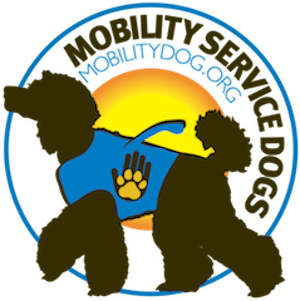Testing a Dog’s Brain for Service Suitability
A Well-Trained Service Dog Sitting in a Store
The traits of a successful service dog are pretty well understood. We want them to be good-tempered (not aggressive), smart and attentive (for trainability), motivated (to help their human companions) and calm (not too excited by external stimuli). They need to respond to reward opportunities and differentiate between familiar human companions and strangers. Although these seem to be fairly basic characteristics for any canine pet, a high percentage of dogs – more than half, by one estimate – fail to show the full range of abilities and temperament necessary to qualify as a service dog.
Moreover, training a service dog requires substantial time and expense. Puppy raisers and dog trainers invest significant effort and resources during the first 18 months of a candidate dog’s life. The associated cost can range between $28,000 and $65,000.
Could Scanning a Dog’s Brain Improve Selection Accuracy?
A Happy Service Dog Laying on the Floor in a Mall
What if we could do a better job of early identification of dogs likely to wash out of service dog training, and thereby reduce this considerable investment? Conversely, behavioral evaluations sometimes produce false negatives: dogs eliminated from training programs even though they might have succeeded with small modifications in experiences or training protocols. The cost of wrongly releasing a dog with potential to succeed is difficult to quantify, but it’s not zero.
The dog behavior specialists who evaluate an animal’s potential as a service dog do a good job of assessing candidates. Nonetheless, any qualitative behavioral assessment is by nature imperfect. In addition, an age-old question faces any evaluator: are the requisite skills and personality features more a function of nature (that is, inherited through the dog’s gene pool) or more attributable to nurture (the training received early on in the dog’s life). The answer, of course, is both.
Canine Brain Scanning
One group of scientists has set about to use canine brain scans to test whether a brain-based classification algorithm could predict more accurately than a qualitative assessment whether an individual animal is likely to succeed as a service dog. *
In this experiment, 49 dogs (some Labrador Retrievers, some Golden Retrievers and some that were mixes of both) were trained to enter an MRI scanning machine and remain still while their brains were scanned. The scientists looked for activation in three regions of the subject animals’ brains:
The caudate region, associated with reward sensitivity.
The amygdala, which responds to positive and negative arousal.
A region of the temporal cortex previously shown to respond to faces.
A Happy Tan Poodle Laying in the Grass
While in the MRI tube, the dogs were shown signs for “treat” and “no treat” by familiar experimenters and by strangers. The scientists then could observe how the dogs’ brains reacted to these stimuli.
Their results suggested that monitoring animals’ responses to rewards and to faces of strangers and familiars does indeed correlate with success and failure in graduating to become a service dog. The experimenters found that responses in the caudate brain region were associated with successful placement in a service dog role. Irrespective of whether a familiar person or a stranger gave the reward signal, a strong response was a positive sign for success.
The dogs’ amygdala responses, and their interaction with the facial recognition brain region, showed the opposite relationship with success. Because amygdala activity rises in reaction to both positive (excitement) and negative (anxiety) stimuli, the experimenters interpreted any amygdala activity as negatively correlated with success. In other words, an animal prone to elevated reaction to either positive or negative interactions may struggle with maintaining the serene demeanor required in a chaotic outside world.
Is It Practical to do MRIs on Dogs?
The Founder of MobilityDog, Janie Heinrich, with her Service Dog at the beach.
Perhaps not, since access to MRI testing is not necessarily easy to arrange. Moreover, the animals that participated in this experiment required training to tolerate the noise and claustrophobic confinement they experienced during the testing. This training required a non-trivial investment of time and effort.
Alternatively, with the expense and time of training a service dog running in the tens of thousands of dollars and many months, perhaps dog brain scans could be seen to generate a positive return on investment.
Either way, this experiment begins to shed light on the brain-based drivers of canine behavior. The resulting insights may open the door to other testing that can give us more clues into how brain function affects the way dogs act and interact with their human companions.
* Berns, G., Brooks, A., Spivak, M. et al. “Functional MRI in Awake Dogs Predicts Suitability for Assistance Work.” Scientific Reports, 7, 43704 (2017). https://doi.org/10.1038/srep43704.
All images Courtesy of Mobility Dogs.




